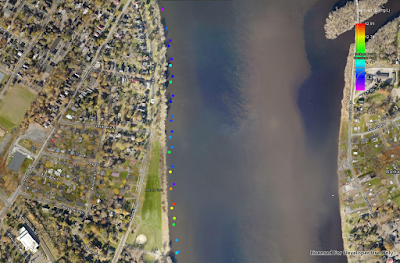Dissolved oxygen levels on Friday (July 24) ranged from 14.2 mg/L to 15.6 mg/L. There had been a strong thunderstorm with about 10 ml of rain, about 5 hours before the readings were taken. Rain water absorbs oxygen from the atmosphere as it falls, so that can increase oxygen levels in surface water, especially near land where the runoff flows into the river.
Dissolved oxygen levels on July 25 ranged from 12.1 mg/L to 12.9 mg/L. The water appeared slightly more cloudy, but there was no visible evidence of any algae.
Later, on the afternoon of the 25th, I took AMOS to the Kelly Creek Basin area near Woolastook. This water was more sheltered, and I wondered if algae would be more plentiful there, with an associated lower level of dissolved oxygen. Indeed, there definitely was more algae, which was noticeably visible in some shallow pockets of still water:
There was also some petroleum-based material just below the algae in this photo.
AMOS recorded more variation in dissolved oxygen here, with levels ranging between 11.1 mg/L and 15.5 mg/L:
The low-ish purple readings in the above image near the small island were near several small patches of algae, where the water was fairly shallow. I would have expected the readings in the small sheltered cove in the western edge of the above map to have had lower dissolved oxygen readings, but actually these readings were at a uniformly good level of about 13.75 mg/L. This area also happened to have a large amount of water grass and other vegetation growing in it, which probably offered a beneficial photosynthesis boost to the oxygen levels there.
I was able to observe a number of small fish in the water, and there were a few people out fishing as well. A couple of them enjoyed paddling out to meet AMOS in the water, and were impressed that it stopped before hitting them and turned to go in a different direction. They even gave AMOS a can of beer. 😊






No comments:
Post a Comment